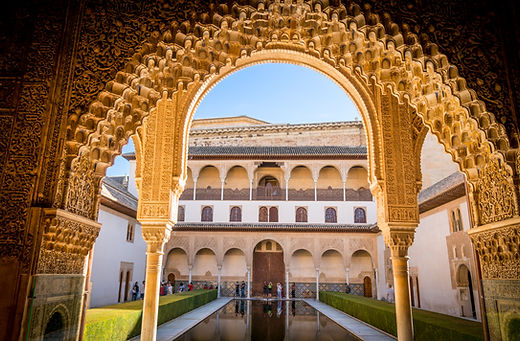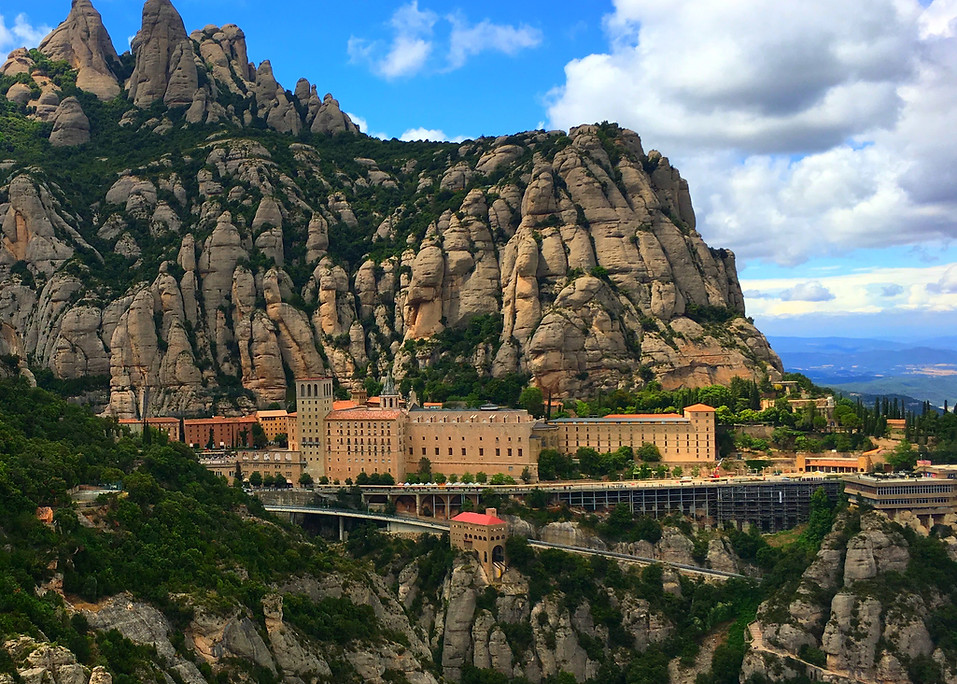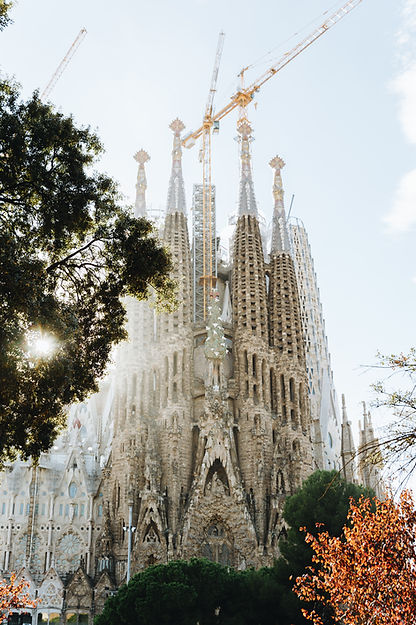

Interesting Facts About Spain
Part 3
Facts 41 - 55
41. A very important and great part of Spanish history began in the year 711. This is the year when the Moors - los moros (from North Africa) began their conquest of the Iberian Peninsula.
This historic event is known as the Moorish Conquest of the Iberian Peninsula. In Spanish, it is called la Conquista Musulmana de la Península Ibérica.
The Moors ruled in Spain (and Portugal) for around 780 years. It was a long period of great culture when education, arts, architecture and science flourished. Many wonderful, Arabic buildings still stand, especially in southern Spain.
However, there was a gradual reversal of the situation, known as la Reconquista Española - the Reconquest - and it ended in 1492.
The last city to remain under Moorish rule was Granada. It was changed to Spanish rule in 1492. The Spanish monarchs at this time were King Ferdinand and Queen Isabella. In Spanish, their names are el Rey Fernando de Castilla y la Reina Isabel de Aragón. They were also known as the Catholic Kings - los Reyes Católicos.


Above: Queen Isabella and King Ferdinand
An interesting fact: Queen Isabella and King Ferdinand were the parents of Catherine of Aragon: the first wife of the English king, Henry VIII. In Spanish, her name is Catalina de Aragón y Castilla.
Portrait below of Catherine of Aragon.

In the map below you can see the various stages of reconquest over many centuries. The gradual reversal of rule took place in a 'north to south' direction - the south remaining Arabic for the longest period of time.

León and Navarra were the first areas to return to Spanish rule.
Castilla and Aragón were the second areas.
Córdoba and Granada were the last to return to Spanish rule.
42. After almost 800 years of Moorish (Arabic) rule, it is not surprising that Spain - particularly in the south - has a great Arabic presence. The Arabic influence is evident in magnificent buildings, the language and the fascinating culture. There are many famous Arabic buildings in Spain, such as la Giralda.


La Giralda is a Moorish tower in the city of Sevilla. It is over 104 metres high.
Originally it was built in the 1100s as the minaret of the Great Mosque of Seville but now it is used as the bell tower of the cathedral.

At the very top of la Giralda there is a bronze statue that represents 'faith' - la fe. The figure is holding a standard in one hand and a palm branch in the other. The standard moves according to the wind direction because it is designed as a weather vane - una veleta. The statue is called el Giraldillo.
La Giralda has the status of a UNESCO World Heritage Site. In Spanish this status is called un patrimonio mundial.

43. The motto of the city of Sevilla is a 'secret code'. It is: NO8DO and it dates back to the 13th century. It was created in gratitude by the Spanish King Alfonso X after the loyal people of Seville supported him in a decision he made.
The number 8 in the middle of the code represents the shape of a skein of wool. In Spanish, this wool shape is called una madeja. When the words of the motto are all placed together you have:-
NO + MADEJA + DO. This sounds like the words: No me ha dejado, meaning - 'He/She/It has not left me.'
In other words, King Alfonso considered the city of Sevilla to be loyal because it did not abandon him.
You will see NO8DO in places all over the city: on buildings, on the flag of Sevilla and on its coat of arms. The motto is written like 13th century mobile phone text language! Cu l8r!



Above: The flag of Sevilla, the coat of arms of Sevilla and an example of una madeja.
44. A magnificent Arabic walled citadel is la Alhambra in Granada. It is one of the most visited places in Spain and has the status of a UNESCO World Heritage Site. It is a complex of palaces, courtyards and gardens and its name comes from the Arabic al-Hamra meaning 'the red one'.
There are two possible reasons why the construction is called 'red':
1. The brickwork can appear red, depending on the light.
2. It is named after Ibn al-Ahmar , an Arabic ruler of Granada, who initiated the building work. He was red-haired. His Arabic name means 'Son of the Red One'. He is also known as Muhammad I, Sultan of Granada.
Below is a photo of la Alhambra.

A famous area within la Alhambra is called el Palacio de Comares. It has a patio with a pond called the Patio of the Myrtles - el Patio de los Arrayanes and a tower called la Torre de Comares, (pictures below).
The photos below were taken from opposite positions: 1. Looking towards the Comares Tower 2. Looking out from an arch beneath the tower.


45. A Moorish area of Granada is called el Albaicín. It is a UNESCO World Heritage Site. It is famous for its Arabic architecture and narrow lanes. The area (el barrio) is situated on a hill overlooking la Alhambra. The original, Moorish entrances to the area still stand.
Below are photos of two of the arched entrances called la Puerta de Elvira and la Puerta de Monaita,


46. A famous military leader of Spain was Rodrigo Díaz de Vivar, also known by the nickname el Cid, meaning - the chief. He had another nickname - el Campeador - meaning the champion of the battlefield.

He was a Spanish nobleman, born around the year 1043 in the town of Vivar, near Burgos. He is portrayed as a heroic soldier in Spanish legends.
El Cid rode a beautiful, white horse named Babieca, meaning - foolish. It is one of the most famous horses in history. El Cid loved his horse and had chosen it against the advice of his godfather who thought that the horse was not very clever. That is why people called it Babieca.
The story of El Cid is told in an epic poem called El Cantar de Mio Cid - The Song of My Cid, written around the year 1200. It is one of the oldest pieces of Spanish literature and is kept at the National Library of Spain - la Biblioteca Nacional de España in Madrid. It consists of 3,735 verses.
Below is a statue in the city of Burgos of el Cid on his horse and also an image of a piece of the famous poem.

.jpg)

According to legend, el Cid died just before an important battle in 1099. His wife, called Jimena, strapped the dead body to his horse. The body was dressed in armour, to make it appear to the army that their great leader was still alive. The soldiers, unaware that el Cid was dead, rode bravely into battle, following him, and they won!
The sword of el Cid can be seen in the Museum of Burgos.
The name of the sword is Tizona. It is believed to be one of the most precious possessions of the Spanish Royal Family.
The tomb of el Cid and his wife Jimena can be found inside Burgos Cathedral - la Catedral de Burgos. The grave of his horse Babieca can be found at the monastery of San Pedro de Cardeña, near to Burgos.
47. Many Spanish words come from Arabic, especially those that begin with the letters al.
The region of southern Spain called Andalucía comes from the Arabic Al-Andalus.
Here are just a few commonly-used words that are really from Arabic:
Ojalá - if only / hopefully (Allah (SWT) is within this word which is really saying 'If God /Allah (SWT) wishes it.')
azúcar - sugar aceite - olive oil aceituna - olive almohada - pillow
ajedrez - chess alcalde - mayor aldea - town naranja - orange zanahoria - carrot
hasta - until alfombra - carpet barrio - neighbourhood jarra - jug azafrán - saffron
alquiler - rent
48. Spain is famous for its many festivals - fiestas. Some of las fiestas are really crazy but great fun!
Perhaps one of the craziest festivals is the massive tomato-throwing event called la Tomatina. It takes place each year on the last Wednesday of August in a town called Buñol in the area of Valencia.
The day begins with a greased pole called el palo jabón. At the top of the pole there is a leg of Spanish ham attached - el jamón. When someone finally manages to climb the difficult, slippery pole and fetch el jamón, the tomato-throwing can officially begin!
For one hour, people throw over-ripe, soft tomatoes at one another in the streets. Tons of tomatoes are offloaded by lorries. Participants shout ¡Tomate! ¡Tomate! during the food-throwing which is called la batalla - the battle.
Below: preparing el palo jabón and la batalla.


49. In the northern city of Pamplona, there is a very famous festival every year from 6 to 14 July. It is a celebration to honour the town's saint - San Fermín. The festival is called las Fiestas de San Fermín or los Sanfermines. The traditional colours to wear during the festival are red and white.
The whole festival begins on 6 July at midday with the setting off of a firework from the town hall building. This firework is called el chupinazo. Throughout the festival there are processions with people dressed in costumes that have gigantic heads! These characters are known as 'giants and big-heads.' In Spanish they are called gigantes y cabezudos.



At 8 o' clock each morning, a rocket is fired and bulls are released to run wild along a prepared route. People show how brave they are by running in front of the charging bulls. Many people are injured and sometimes they are killed. This 'running of the bulls' is known as el encierro.
The half-mile route that the bulls are forced to follow takes them to the town's bullfighting arena where they will be later involved in the bullfights.
The festival ends at midnight on 14 July in front of the town hall - el ayuntamiento - with the crowds singing a song of farewell to the festival. This song is called Pobre de Mí - Poor Me.
People hold a lighted candle as they sing - Pobre de mí, pobre de mí, que se han acabado las fiestas de San Fermín - Poor me, poor me, for the Saint Fermin festivities have ended.
50. Spain is famous for its mountains. La Sierra Nevada is the highest mountain range on the Spanish mainland, with the highest peak (a mountain called el Mulhacén) reaching 3478 metres.
The name Sierra Nevada means snowy mountain range and it is situated in the southern region of Andalucía. It is a well-known skiing resort.
(Note: The volcano El Teide is the highest Spanish mountain but it is situated away from the Spanish mainland, on the Canary Islands).
Montserrat is a mountain range in the Cataluña area of Spain. Its name in Catalan literally means 'serrated mountain.' It has been given this name because the rock really does look as if it has been cut with a serrated blade! The highest point of Montserrat is over 1200 metres. Within this mountain range there is a famous monastery called el Monasterio de Santa María de Montserrat.
In the photo below you can see the monastery and the interesting 'serrated' rock formation of the mountain.

The monastery keeps a famous and sacred statue of the Virgin Mary. She is known as la Virgen de Montserrat (Our Lady of Montserrat). The statue is also known as la Moreneta meaning The Little Dark Lady.
Our Lady of Montserrat is one of the two patron saints of Cataluña and her feast day is 27 April.
Note: Cataluña has another patron saint: Saint George, known as Sant Jordi in Catalan and San Jorge in standard Castilian Spanish. His feast day is celebrated on 23 April.
The monastery is also the home of a world-famous boys' choir and music school called la Escolanía de Montserrat. The boys are aged between nine and fourteen years and come from the regions of Cataluña, Islas Baleares and Valencia. It is one of the oldest choirs in Europe and the singers perform every day in the monastery.

51. In the city of Córdoba, in the region of Andalucía, there is a famous mosque-cathedral called la Mezquita-Catedral de Córdoba. Originally, it was built as the Great Mosque of Córdoba and it is another example of magnificent, Moorish architecture in Spain.
Construction began in the 8th century under the Arabic rule of Abd al-Rahman I, the Emir of Córdoba. In Spanish, this ruler's name is Abderramán I.


The building has been extended over many centuries.
The interior is well-known for its hall of arches supported on columns.
The mosque-cathedral of Córdoba is a UNESCO World Heritage Site - un patrimonio mundial.

Image: una puerta de la mezquita-catedral - a door of the mosque-cathedral.
52. The River Tagus is the longest river of the Iberian Peninsula. In Spanish, it is called el río Tajo. It begins in a mountain range called la Sierra de Albarracín in eastern Spain and it flows for a distance of 1007 kilometres. The river ends at Lisbon in Portugal where it flows into the Atlantic Ocean - el Océano Atlántico.
Another famous Spanish river is el Guadalquivir. It flows through the cities of Sevilla and Córdoba.

53. In the south of Spain, there is a long stretch of beach called Matalascañas. This beach is very well-known because of a strange object that lies on its sand in shallow sea. It is the overturned base of an ancient watchtower!
This upside-down ruin is called la Torre de la Higuera, literally meaning 'the Tower of the Fig Tree'.
The ruin also has the nicknames la Peña, meaning 'the Rock' and el Tapón, meaning 'the bottle top / cork' because it looks like one!
54. One of the most famous buildings in Spain can be found in Barcelona. It is an enormous church in Gothic style called la Sagrada Familia (the Holy Family). Its official name in the local Catalan language is Templo Expiatori de la Sagrada Família.
It was designed by the famous architect Antoni Gaudí. He died in 1926 before finishing the project.
La Sagrada Familia is still an unfinished basilica. It is amazing to think that construction began in the 1880s but the building work continues today! It is planned to complete the basilica in 2026 to celebrate the 100th anniversary of Antoni Gaudí's death.
Gaudí was laid to rest in the crypt of the basilica.
Images: the unfinished basilica of la Sagrada Familia with visible construction work taking place.


55. During a Spanish wedding ceremony, the couple exchange thirteen coins called las arras. These coins are exchanged in addition to wedding rings.
Pregunta: Why are there thirteen coins?
Respuesta: There is one coin to represent good fortune for the newly-weds during each of the twelve months of every year and one extra coin to represent the generosity that they will show towards those who are less fortunate.
Traditionally, the coins are made of either gold or silver and are conserved in a decorative presentation box.
la boda = the wedding
la alianza = the wedding ring
los novios = the bride and groom / the couple who are engaged to be married
